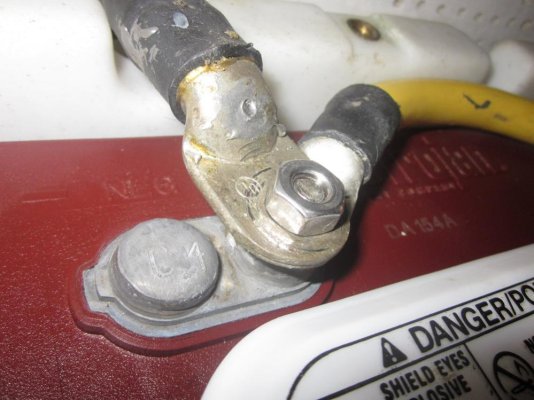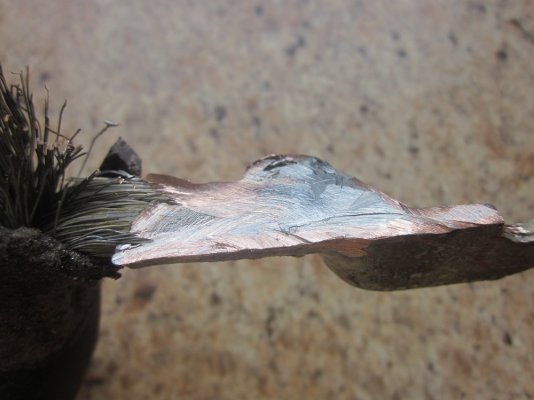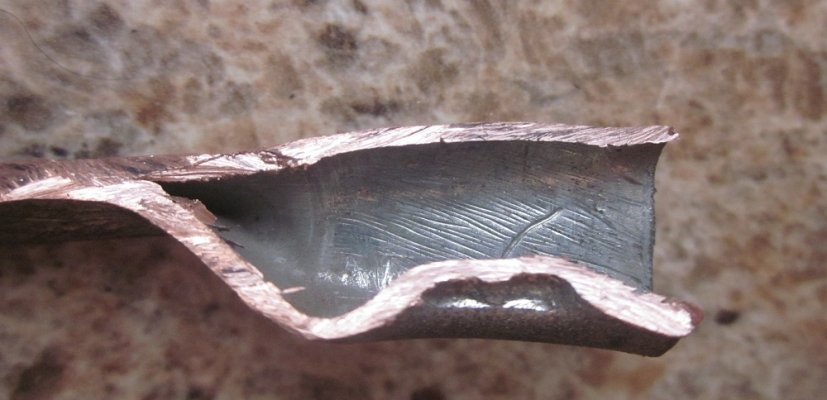In the case of main DC cabling, is there any benefit of soldering the cable connectors in addition to the crimp ? ( It goes without saying that heat shrink is a must in either case. ) What about any other important secondary DC wiring as well .. ?
You are using an out of date browser. It may not display this or other websites correctly.
You should upgrade or use an alternative browser.
You should upgrade or use an alternative browser.
Crimp or and Solder
- Thread starter Ex Sailor
- Start date
The friendliest place on the web for anyone who enjoys boating.
If you have answers, please help by responding to the unanswered posts.
If you have answers, please help by responding to the unanswered posts.
dhmeissner
Guru
- Joined
- Sep 26, 2012
- Messages
- 1,569
- Location
- North America
- Vessel Name
- The Promise
- Vessel Make
- Roughwater 35
In the case of main DC cabling, is there any benefit of soldering the cable connectors in addition to the crimp ? ( It goes without saying that heat shrink is a must in either case. ) What about any other important secondary DC wiring as well .. ?
Hi Mr ES, there is no benefit soldering a properly crimped connection. Use quality cable and lugs.
Making Your Own Battery Cables Photo Gallery by Compass Marine How To at pbase.com
Tom.B
Moderator Emeritus
- Joined
- Jul 30, 2009
- Messages
- 5,839
- Location
- USA
- Vessel Name
- Skinny Dippin'
- Vessel Make
- Navigator 4200 Classic
On a boat, I will always crimp over solder. Solder can get brittle and crack under the constant vibration a boat can have. Proper crimping is easy with the right tools.
Aaaaaand... What Dave said ;-)
Aaaaaand... What Dave said ;-)
I'm with Tom & Dave
Compass Marine has some great "How To's" - Several on crimping tools, crimps etc...
RC knows his stuff and has done a great job of sharing.
I've tried to buy components from him vs a "big box" marine supply as a reward.
Compass Marine has some great "How To's" - Several on crimping tools, crimps etc...
RC knows his stuff and has done a great job of sharing.
I've tried to buy components from him vs a "big box" marine supply as a reward.
jleonard
Guru
- Joined
- Jun 25, 2008
- Messages
- 5,063
Here is a crimping guide from Molex who makes crimping tooling. I used this for training in my previous job. (when I started there none of the operators knew what to measure, look for etc.) The largest they discuss is #8 wire, but the principles apply to any wire size.
Some may find this helpful....
Some may find this helpful....
Attachments
Old deckhand
Guru
Here is a crimping guide from Molex who makes crimping tooling. I used this for training in my previous job. (when I started there none of the operators knew what to measure, look for etc.) The largest they discuss is #8 wire, but the principles apply to any wire size.
Some may find this helpful....
Sweet, thank you!
Brooksie
Guru
- Joined
- Oct 20, 2007
- Messages
- 1,310
- Location
- USA
- Vessel Name
- Island Seeker
- Vessel Make
- Willard 36 Sedan
Agree with above, crimping with a proper crimper is the way to go for several reasons. Soldering by itself, w/o crimping too, is not a good or allowed option. I like to buy plain teminals, crimp them, then add adhesive lined shrink tubing.
I think you willl like this place for supplies
Welcome to Waytek
I think you willl like this place for supplies
Welcome to Waytek
Tom.B
Moderator Emeritus
- Joined
- Jul 30, 2009
- Messages
- 5,839
- Location
- USA
- Vessel Name
- Skinny Dippin'
- Vessel Make
- Navigator 4200 Classic
I think you willl like this place for supplies
Welcome to Waytek
WOW! That place is awesome. Thanks.
AKDoug
Guru
It is a very good idea to apply a small dab of dielectric grease inside the crimp to prevent the possibility of corrosion between wire and crimp before crimping, and then to apply your heat shrink over the top of the connection. This is a practice I use even with end connections.
MYTraveler
Guru
I do both, even though I know soldering is at least frowned upon. In my view, crimping and soldering address two different risks of failure. Crimping is important to establish a secure mechanical connection. Although often used for that purpose, soldering is does not create as reliable mechanical connection. On the other hand, solder is very effective at making and keeping a low resistance connection. Arguably, liquid tape should be as effective, but in my experience it is not, so I crimp and solder and sometimes put liquid tape on top of that.
Capricorn1
Member
I always crimp then run a bit of solder over especially if the terminals are in the bilge area as it stops any electrolytic reaction between dissimilar metals
On our battery terminals, crimp and solder. I drill a hole at the head of the lug to fill any voids with solder; pic 1.
Pic 2 is a soldered lug a cut apart. The last one was crimped with a hammer style crimper. Pretty good contact from the looks of the inside of the lug.
Pic 2 is a soldered lug a cut apart. The last one was crimped with a hammer style crimper. Pretty good contact from the looks of the inside of the lug.
Attachments
what_barnacles
Guru
bestboatwire will build battery cables to suit. Crimping a 4/0 cable is tough without the right tool.
http://www.bestboatwire.com/custom-cables/custom-battery-cable-assembly
http://www.bestboatwire.com/custom-cables/custom-battery-cable-assembly
- Joined
- Apr 15, 2008
- Messages
- 13,731
- Location
- California Delta
- Vessel Name
- FlyWright
- Vessel Make
- 1977 Marshall Californian 34 LRC
FF
Guru
- Joined
- Oct 12, 2007
- Messages
- 22,552
The requirement is to have BOTH a mechanical and an electrical connection.
The "claim" is with the proper marine crimping tool that the solder on the tinned wire , and the solder on the marine tinned connector will cold flow .
Soldering , done properly after the crimp has no down side .
The "claim" is with the proper marine crimping tool that the solder on the tinned wire , and the solder on the marine tinned connector will cold flow .
Soldering , done properly after the crimp has no down side .
dhmeissner
Guru
- Joined
- Sep 26, 2012
- Messages
- 1,569
- Location
- North America
- Vessel Name
- The Promise
- Vessel Make
- Roughwater 35
Good perspectives...
I think this is in complete agreement w RC @ Compass Marine.
His .sectioned sample crimps show NO voids... I think I recall he tried adding solder and got no penetration into a properly done crimp
Thanks for sharing
AKDoug
Guru
Passagemaker did an in depth article on electrical connections and specifically recommended NOT soldering the connections, as it hardened the joint and made it prone to cracking (in their opinion). I suppose it makes a difference whether or not the connection is a terminal one that will never be subject to being flexed, or if there will be movement in the wire harness.
- Joined
- Mar 17, 2012
- Messages
- 4,279
- Location
- Australia
- Vessel Name
- Insequent
- Vessel Make
- Ocean Alexander 50 Mk I
A good chandler will have a high quality crimper available for use on lugs/wire you are buying from them. So go in with a list of cable lengths required and you are set. I personally prefer the dielectric grease alternative to solder, but many times simply crimp without either. I would never just solder for marine connections. And for smaller wires, use your own ratcheting crimper....
I always crimp then run a bit of solder over especially if the terminals are in the bilge area as it stops any electrolytic reaction between dissimilar metals
You can't "run a bit of solder over" a connection and expect it to accomplish anything. You either heat the cable and the connector to the point where solder flows freely into the joint or your technique does nothing at all. More than likely, doing this will melt the insulation and solder wicking up the wire will make it stiff and subject to metal fatigue.
A properly crimped connection will be tight enough that there is no place for solder to flow.
............... I personally prefer the dielectric grease alternative to solder, ....
Dielectric grease is not an alternative to solder. "Dielectric", by definition DOES NOT conduct electricity. It's purpose on electrical connections is to exclude air and moisture. When used on plugs and sockets, etc., the action of inserting the plug scrapes the dielectric grease off the mating conductors while leaving enough to protect the connection.
If you want to smear dielectric grease on the terminal after crimping, that's fine but heat shrink tubing is better. Both is best and you can buy terminals with dielectric filled heat shrink tubing attached.
what_barnacles
Guru
The requirement is to have BOTH a mechanical and an electrical connection.
Isnt the C.G. requirement that no connection can be of solder alone? Crimping by itself is ok.
Capricorn1
Member
Sorry totally disagree. I have over the years seen many crimped joints fail due to electrolytic reaction. I always crimp my connections using a proper crimp tool and then apply solder using flux. If soldering is done correctly the solder should not wick past the end of the terminal leaving the cable flexible. I am not overly concerned if the plastic on the crimp melts.You can't "run a bit of solder over" a connection and expect it to accomplish anything. You either heat the cable and the connector to the point where solder flows freely into the joint or your technique does nothing at all. More than likely, doing this will melt the insulation and solder wicking up the wire will make it stiff and subject to metal fatigue.
A properly crimped connection will be tight enough that there is no place for solder to flow.
jwnall
Moderator Emeritus
You can't "run a bit of solder over" a connection and expect it to accomplish anything. You either heat the cable and the connector to the point where solder flows freely into the joint or your technique does nothing at all. More than likely, doing this will melt the insulation and solder wicking up the wire will make it stiff and subject to metal fatigue.
A properly crimped connection will be tight enough that there is no place for solder to flow.
+1.
- Joined
- Mar 17, 2012
- Messages
- 4,279
- Location
- Australia
- Vessel Name
- Insequent
- Vessel Make
- Ocean Alexander 50 Mk I
Dielectric grease is not an alternative to solder. "Dielectric", by definition DOES NOT conduct electricity. It's purpose on electrical connections is to exclude air and moisture. When used on plugs and sockets, etc., the action of inserting the plug scrapes the dielectric grease off the mating conductors while leaving enough to protect the connection.
If you want to smear dielectric grease on the terminal after crimping, that's fine but heat shrink tubing is better. Both is best and you can buy terminals with dielectric filled heat shrink tubing attached.
Probably a good thing I usually just crimp then! With heat shrink afterwards. Only occasionally do I get the urge to use grease, from now on it might be even less!
caltexflanc
Guru
WesK: you are on the money! Soldering may "help" crappy crimps, the moral of the story is don't make crappy crimps.
FF
Guru
- Joined
- Oct 12, 2007
- Messages
- 22,552
"Soldering may "help" crappy crimps, the moral of the story is don't make crappy crimps."
The hassle is folks attempt to do marine electrical with auto terminal ends and auto crimp tools.
The Anchor brand wire , terminal end and crimping tool ( $ 80. or so) is OK , even for USCG inspected boats.
The usual hassle with soldering is folks do not have the proper heating tools.
A home soldering iron or gun has not enough heat to work.
It will heat the terminal end , but takes so long some of the wire is also melting and getting stiff.
My solution is to put flux on the wire , before inserting it in the terminal end.
Then a 3 -5 lb copper roofing iron is heated with a propane torch . Flea market item.
Just a touch of the heavy hot iron will do the job , flow the solder with out harming that nice multi-strand wire you bought.
Heat shrink tape is always an added plus.
The hassle is folks attempt to do marine electrical with auto terminal ends and auto crimp tools.
The Anchor brand wire , terminal end and crimping tool ( $ 80. or so) is OK , even for USCG inspected boats.
The usual hassle with soldering is folks do not have the proper heating tools.
A home soldering iron or gun has not enough heat to work.
It will heat the terminal end , but takes so long some of the wire is also melting and getting stiff.
My solution is to put flux on the wire , before inserting it in the terminal end.
Then a 3 -5 lb copper roofing iron is heated with a propane torch . Flea market item.
Just a touch of the heavy hot iron will do the job , flow the solder with out harming that nice multi-strand wire you bought.
Heat shrink tape is always an added plus.
Similar threads
- Replies
- 53
- Views
- 3K
- Replies
- 36
- Views
- 4K
- Replies
- 6
- Views
- 737
- Replies
- 9
- Views
- 773
- Replies
- 10
- Views
- 888




